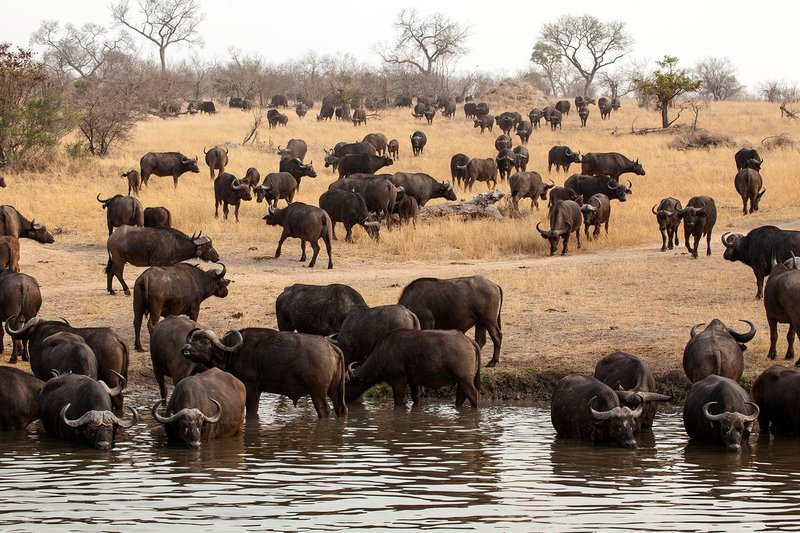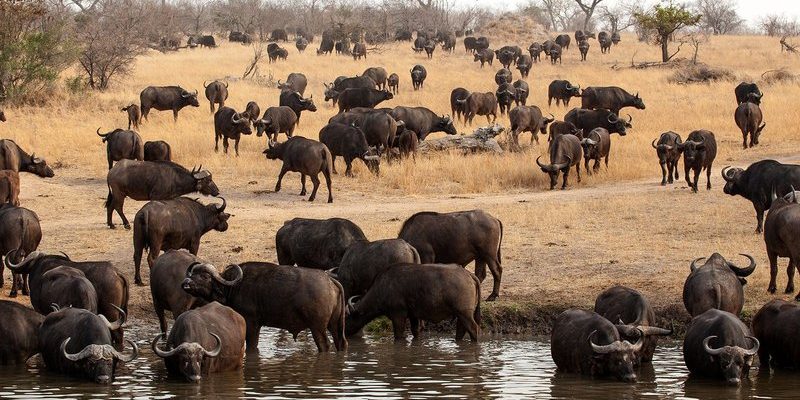
African buffalos, often referred to as the “Black Death” by those who encounter them, have a reputation for being one of the most formidable animals in Africa. Despite their slow-moving demeanor, they are surprisingly agile and social, relying heavily on their herds to survive. I mean, let’s be honest: if you’re facing predators like lions or crocodiles, having friends around is a major advantage! But how exactly do buffalos navigate their often unforgiving habitats? Let’s dive in and explore the remarkable strategies these animals employ.
Their Physical Strength: A Key to Survival
First off, let’s talk about the physical characteristics that make African buffalos such survivors. With their broad bodies, powerful legs, and muscular builds, these animals are built for resilience. The buffalos’ thick skin serves as a shield against harsh weather conditions and insects. Just picture them standing under the blazing sun, their tough skin acting like armor while they search for shade or water.
One of their most striking features is those impressive horns. Not only do they help in fights against predators, but they also demonstrate strength within the herd. Buffalos are known for their unique way of fighting off threats: they’ll form a protective circle with their young at the center, using their horns to fend off attackers. This teamwork allows them to defend against even the most relentless predators.
As they carve out their niche in the ecosystem, buffalos often weigh between 1,000 to 2,000 pounds! That’s more than most people’s cars! Their sheer size makes them intimidating, but it’s their teamwork and social structure that truly help them survive.
Water Sources: An Essential Lifeline
You might be wondering how buffalos deal with the extreme conditions of the African climate, especially when it comes to staying hydrated. Water is an essential part of their survival, and these creatures are quite resourceful in finding it. They typically stick close to rivers and lakes, but during dry seasons, these water sources can become scarce.
Buffalos have an incredible ability to adapt. They can travel great distances to find water, sometimes walking several miles to get to a river or watering hole. It’s like having a built-in GPS for survival! Their strong sense of smell helps them locate water from far away, which is crucial when resources are low.
Moreover, buffalos are known to dig for water. That’s right! When a watering hole dries up, they can use their hooves to dig down into the ground to find moisture. This helps not only them but also other animals that might be struggling in the arid landscape. It’s a win-win situation for them and their neighbors.
Diet and Grazing Habits: Nature’s Buffet
So, what do African buffalos eat? These big guys are herbivores, and their diet is mainly made up of grasses, leaves, and shoots. They’re like the lawnmowers of the savannah, eating vast amounts of vegetation to sustain their massive bodies. Their broad, flat mouths are perfect for grazing on grasses that others might overlook.
During dry seasons, buffalos can rummage through bushes and trees to find leaves. This adaptability is vital for their survival. It’s fascinating to think that these creatures can switch their diets based on what is available, much like how we might change our meals depending on what we have in the fridge.
Another interesting fact about buffalos is their role in their ecosystem. As they graze, they help manage plant growth and promote biodiversity. Their feeding habits can help create habitats for other species, proving that even in a harsh environment, they play a crucial part in maintaining balance in the ecosystem.
Social Structure: Strength in Numbers
African buffalos are highly social animals that live in herds, which provides them with several advantages. You could think of their herds as a big family, where together they tackle challenges and enjoy communal living. These herds can range from a few dozen to several hundred individuals. Being part of a herd not only provides safety in numbers but also enhances their chances of finding food and water.
Inside the herd, buffalos maintain a clear social hierarchy, often led by a dominant female. This order is essential, especially in times of crisis. When a predator approaches, the herd instinct kicks in, and they band together to fend off threats. It’s a sight to see: massive bodies working in unison, horns glinting in the sunlight, all to protect their young.
Their social nature also plays a role in raising calves. Mothers are attentive, and the calves often play together, learning social skills that will help them as adults. Their strong bonds help them navigate the tough times, fostering a sense of community that adds to their survival.
Predator Awareness: Staying One Step Ahead
In the wild, danger is always lurking. For buffalos, lions, crocodiles, and even hyenas pose serious threats. But these intelligent animals have developed keen senses to help them stay alert. With excellent hearing and eyesight, they are often able to spot a predator from a distance.
When danger strikes, buffalos are known for their defensive strategies. Instead of running away, they’ll stand their ground and face the threat. It’s a bit like a football team lining up for a play: they know their roles and are ready to protect their teammates. This ferocity is surprising to many, considering their bulky appearance.
Their *herd mentality* adds another layer of protection. Buffalos work together to fend off predators, often circling around their young and using their horns to intimidate attackers. This collective effort can be quite effective. It’s a lesson in teamwork that spans beyond species.
Resilience in Changing Environments
Lastly, let’s talk about how buffalos have adapted to changing environments over time. With climate change and habitat destruction, many species are struggling to keep pace. However, African buffalos are remarkably resilient. They are known to inhabit a range of environments, from grasslands to forests, demonstrating their ability to adjust to different conditions.
As their habitats change, buffalos often shift their migration patterns. They follow the rain, seeking out lush grazing land whenever possible. It’s like they have an internal compass guiding them toward greener pastures, literally! This movement is crucial for their survival, as it allows them to find food and water while avoiding overgrazed areas.
Additionally, their adaptability to different surroundings has also made them a significant species for conservation efforts. When protected and allowed to thrive, buffalos can help restore degraded ecosystems. Their natural behavior contributes to soil health and vegetation diversity, making them an essential species in the ecological balance.
In conclusion, African buffalos are truly remarkable animals. From their physical strength and social structures to their feeding habits and adaptability, they have developed a unique set of survival strategies that allow them to thrive in harsh environments. Whether they are defending their young or forging new paths in search of water, buffalos remind us of the power of resilience and community in overcoming challenges. Next time you think about buffalos, remember: these tough survivors have an incredible story worth celebrating!

